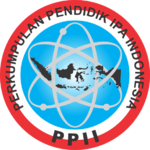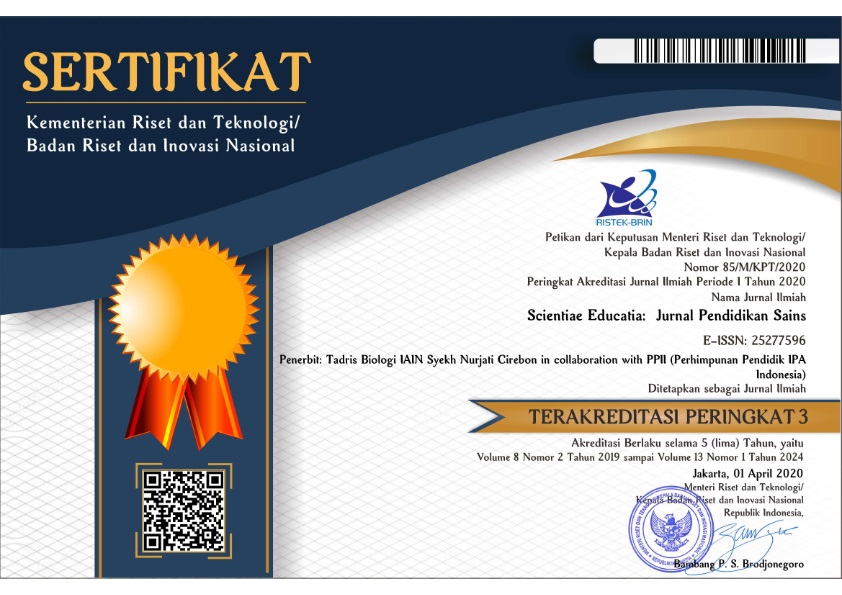Transformation in Biology Learning during the Covid-19 Pandemic: From Offline to Online
(1) Biology Education Study Program, Faculty of Mathematics and Sciences, Yogyakarta State University, Yogyakarta
(2) Biology Education Study Program, Faculty of Mathematics and Sciences, Yogyakarta State University, Yogyakarta
(3) Biology Education Study Program, Faculty of Mathematics and Sciences, Yogyakarta State University, Yogyakarta
(*) Corresponding Author
Abstract
Keywords
Full Text:
PDFReferences
Anderson, J., & McCormick, R. (2005). Ten pedagogic principals on e-learning, observatory for new technologies and education. In It’s Learning Springboar to Knowledge.
Asosiasi Penyedia Jaringan Internet Indonesia (APJII). (2016). Penetrasi & perilaku pengguna internet di Indonesia. https://apjii.or.id/downfile/file/surveipenetrasiinternet2016.pdf
Bakia, M., Shear, L., Toyama, Y., & Lasseter, A. (2012). Understanding the implications of online learning for educational productivity. Office of Educational Technology, US Department of Education.
Chaeruman, U. A. (2013). Merancang model blended learning. Jurnal Teknodik, 17(4), 53-63.
Chaeruman, U. A. (2017). PEDATI, model desain sistem pembelajaran blended. Direktorat Pembelajaran Kementerian Riset, Teknologi dan Pendidikan Tinggi.
Cholik, C. A. (2017). Pemanfaatan Teknologi Infpormasi dan Komunikasi untuk Meningkatkan Pendidikan di Indonesia. Syntax Literate : Jurnal Ilmiah Indonesia, 2(6), 21–30.
De Giusti, A. (2020). Policy Brief: Education during COVID-19 and beyond. Revista Iberoamericana de TecnologÃa en Educación y Educación en TecnologÃa, (26), e12-e12.
Fadde, P. J., & Vu, P. (2014). Blended online learning: Benefits, challenges, and misconceptions. Online Learning: Common Misconceptions, Benefits, and Challenges, 33–47.
Fauzi, I., & Khusuma, I. H. S. (2020). Teachers’ elementary school in online learning of COVID-19 pandemic conditions. Jurnal Iqra’ : Kajian Ilmu Pendidikan, 5(1), 58–70.
Giatman, M., Siswati, S., & Basri, I. Y. (2020). Online learning quality control in the pandemic Covid-19 era in Indonesia. Journal of Nonformal Education, 6(2), 168–175.
Hrastinski, S. (2008). Asynchronous & Synchronous E-Learning. In Educasue Querterly (Issue 4, pp. 51–55). https://doi.org/10.1080/00071667608416307
Khan, B. (2005). Managing e-learning strategies: Design, delivery, implementation and evaluation. Idea Group Inc.
Khastini, R. O. (2020). Peningkatkan kemampuan berpikir kritis melalui scaffolding dalam pembelajaran biologi umum pada masa pandemi Covid-19. Journal of Chemical Information and Modeling, 3(1), 20–27.
Malik, M., Fatima, G., Hussain Ch., A., & Sarwar, A. (2017). E-learning: Students’ perspectives about asynchronous and synchronous resources at higher education level. Bulletin of Education and Research, 39(2), 183–195.
Martha, Z. D., Adi, E. P., & Soepriyanto, Y. (2018). E-book berbasis Mobile learning. Jurnal Kajian Teknologi Pendidikan, 1(2), 109–114.
Martin, F., & Parker, M. (2014). Use of synchronous virtual classrooms: Why, who, and how? Journal of Online Learning and Teaching, 10(2), 192.
Martin, F., Polly, D., & Ritzhaupt, A. (2020). Bichronous online learning: Blending asynchronous and synchronous online learning. EDUCAUSE Review, September 1–11. Retrieved from https://er.educause.edu/articles/2020/9/bichronous-online-learning-blending-asynchronous-and-synchronous-online-learning
Moser, S., & Smith, P. (2015). Benefits of synchronous online courses. In Association Supporting Computer Users in Education (ASCUE ) Proceeding. pp. 43-48.
Muamar. (2015). Peran komunikasi guru dengan siswa dalam mengembangkan motivasi belajar mata pelajaran aqidah akhlaq siswa kls VII MTs. Mabdaul Huda Karangaji Kecamatan Kedung Kabupaten Jepara Tahun Pelajaran 2014/2015. http://eprints.unisnu.ac.id/653/1/131310001360 Muamar %28Upload%29.pdf
Murphy, E., RodrÃguez-Manzanares, M. A., & Barbour, M. (2011). Asynchronous and synchronous online teaching: Perspectives of Canadian high school distance education teachers. British Journal of Educational Technology, 42(4), 583–591.
Mustakim. (2020). Efektivitas pembelajaran daring menggunakan media online selama pandemi Covid-19 pada mata pelajaran matematika the effectiveness of e-learning using online media during the Covid-19 pandemic in mathematics. Al Asma: Journal of Islamic Education, 2(1), 1–12.
Nguyen, T. (2015). The effectiveness of online learning: beyond no significant difference and future horizons. MERLOT Journal of Online Learning and Teaching, 11(2), 309–319.
Onyema, E. M. (2020). Impact of Coronavirus pandemic on education. Journal of Education and Practice, 11(13), 108–121.
Pawicara, R., & Conilie, M. (2020). Analisis pembelajaran daring terhadap kejenuhan belajar mahasiswa Tadris Biologi IAIN Jember di tengah pandemi Covid-19. ALVEOLI: Jurnal Pendidikan Biologi, 1(1), 29–38.
Perangin, A., & Ekawalta, E. S. (2020). Upaya meningkatkan atensi siswa kelas VI SD dalam proses pembelajaran daring melalui media visual. Universitas Pelita Harapan. http://repository.uph.edu/11968/
Perveen, A. (2016). Synchronous and asynchronous e-language learning: A case study of virtual University of Pakistan. Open Praxis, 8(1), 21–39.
Power, M. (2008). The emergence of a blended online learning environment. Journal of Online Learning and Teaching, 4(4), 503–514.
Raharjo, E. Y. (2020). Efektifitas Pembelajaran daring tipe numbered heads together terhadap hasil belajar. Universitas Muhammadiyah Malang. Retrieved from http://eprints.umm.ac.id/69318/
Reimers, F., Schleicher, A., Saavedra, J., & Tuominen, S. (2020). Supporting the continuation of teaching and learning during the COVID-19 pandemic. Annotated resources for online learning. OECD, 1–38.
Sirate, S. F., & Yaumi, M. (2017). Perspektif belajar sebagai landasan psikologis dalam pengembangan media dan teknologi pembelajaran. Lentera Pendidikan : Jurnal Ilmu Tarbiyah dan Keguruan, 20(1), 98–111.
Sanjaya, F. R. (2020). 21 refleksi pembelajaran daring di masa darurat (F. R. Sanjaya (ed.)). Universitas Katolik Soegijapranata. Retrieved from http://repository.unika.ac.id/22884/1/April 13-2020_21
Sari, S. A. S. W. (2020). Efektivitas pembelajaran e-learning mahasiswa Prodi Pendidikan Biologi FKIP Universitas Muhammadiyah Surakarta pada Praktikum mikrobiologi selama pandemi Covid19 tahun akademik 2019/2020. http://eprints.ums.ac.id/86538/16/2. Naskah publikasi.pdf
Satgas Covid-19. (2020). Peta Zona Resiko Covid-19. https://covid19.go.id/peta-risiko
Schleicher, A. (2020). The impact of covid-19 on education insights from education at a glance 2020. OECD. Retrieved from https://www.oecd.org/education/the-impact-of-covid-19-on-education-insights-education-at-a-glance-2020.pdf.
Simaremare, R. (2009). Teknologi informasi dan dunia pendidikan. Jurnal Bahas, 18(02). http://jurnal.unimed.ac.id/2012/index.php/bahas/article/view/2497
Susantono, B., Sawada, Y., & Park, C. Y. (2020). Navigating COVID-19 in Asia and the Pacific. Asian Development Bank. Retrieved from http://hdl.handle.net/11540/12484
Syah, R. H. (2020). Dampak Covid-19 pada pendidikan di Indonesia: Sekolah, keterampilan, dan proses pembelajaran. SALAM: Jurnal Sosial Dan Budaya Syar-I, 7(5), 395-402.
United Cities and Local Governments, Metropolis, & UN-Habitat. (2020). Digital technologies and COVID-19 pandemic. Beyond The Outbreak Live Learning Experience (LLE) Virtual, 15(04).
Vonderwell, S., Liang, X., & Alderman, K. (2007). Asynchronous discussions and assessment in online learning. Journal of Research on Technology in Education, 39(3), 309-328.
Wahyono, P., Husamah, H., & Budi, A. S. (2020). Guru profesional di masa pandemi COVID-19: Review implementasi, tantangan, dan solusi pembelajaran daring. Jurnal Pendidikan Profesi Guru, 1(1), 51–65.
Wayne, D. B., Green, M., & Neilson, E. G. (2020). Medical education in the time of COVID-19. Science Advances, 6(31), 1-3.
Yamagata, L. C. (2020). Blending online asynchronous and synchronous learning. The International Review of Research in Open and Distributed Learning, 15(2), 189–212.
DOI: 10.24235/sc.educatia.v9i2.7381
Article Metrics
Abstract view : 46 timesPDF - 10 times
Refbacks
- There are currently no refbacks.
Scientiae Educatia: Jurnal Pendidikan Sains indexed by:

This work is licensed under a Creative Commons Attribution 4.0 International License.



1.png)












